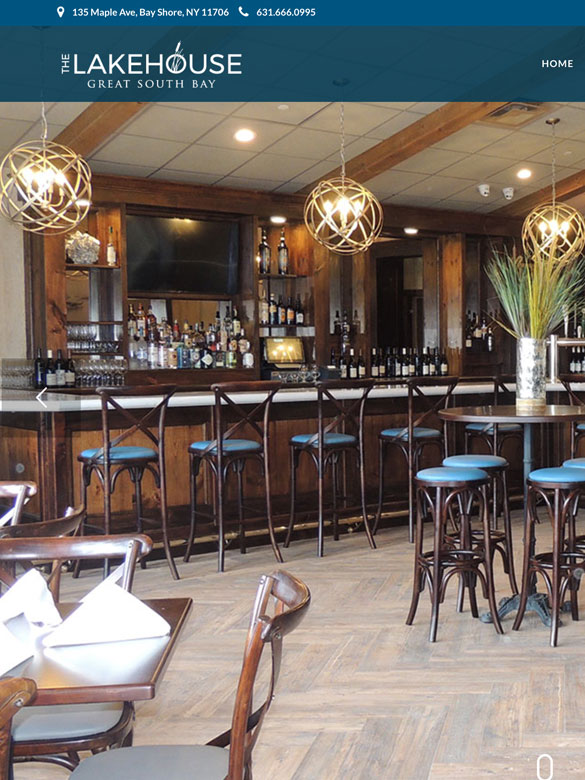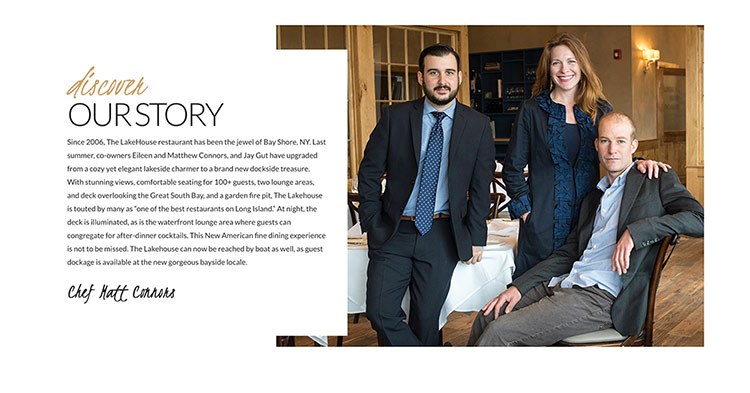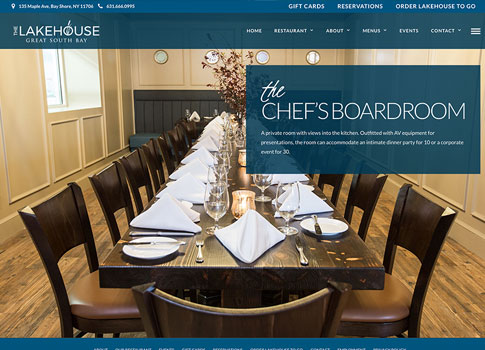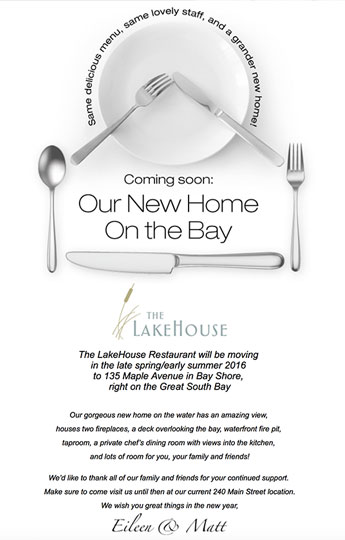The LakeHouse Great South Bay
Content + Visual Development, Design + Identity, Web Development, Digital Marketing
The LakeHouse Great South Bay has been the jewel of Bay Shore, Long Island NY since 2006. With stunning views, comfortable seating for 100+ guests, two lounge areas, and deck overlooking the Great South Bay, this family-owned and run restaurant is warm and inviting with an impeccable dining experience.
We were hired a second time to develop another new brand for The LakeHouse. We created a new logo, new branded e-commerce website, print materials and email marketing promotions. We focus on user experience, creation of visual impact, and strong brand communication, ensuring a clear brand experience.




“The LakeHouse is touted by many as “one of the best restaurants on Long Island. This New American fine dining experience is not to be missed.”
Behind the Scenes
We started with a new logo, keeping some of the elements from the original one. Since the business was moving to a bigger location from the lake to the bay, the Sharkey team produced a new web presence to depict their new location, new menu, and new offerings.
Client: The LakeHouse Great South Bay






DID YOU KNOW?
Things to avoid when building a branded e-commerce website
1. Make a website without expert help.
Your website if often a customer’s first time seeing your company and your brand. If the website doesn’t succeed in grabbing their attention, it may also be their last. An unprofessional looking website will reflect poorly on your business as a whole, but a beautifully designed website will ensure that a customer’s first impression is a positive one.
2. Make them search for what they want.
Customers don’t want to work to find the information they need on your website. A confusing webpage, or one that neglects to include important information, could turn away customers. They could very well get impatient and leave rather than take the effort to search through your site for what they want. Think about some of the most common and important questions a customer will have when first visiting your website. Make sure you answer these questions, and make sure the answers are easy to find.
3. Overwhelm a customer.
While it’s essential to have important information clearly placed, it’s also possible to overwhelm a customer with too much information. If you have many products or services, you don’t necessarily won’t to show them all off on the same page. Too many choices may actually result in your customer not knowing what to do next. Keep your pages simple, and give customers clear paths to navigate the site so that they can find whatever they may be specifically looking for by themselves. On top of this, trying to cram too much into one page will make your website look cluttered. Make sure to space out your content and give your customers some breathing room.
4. Assume you’ll get visitors right away.
Just building the website isn’t a guarantee that potential customers will show up to it. Your website is the backbone of your marketing strategy, but it isn’t your entire strategy. You need to combine a great website with other forms of marketing to generate traffic and gain customers. One way to greatly improve your website traffic is to implement Search Engine Optimization (SEO). It begins with a Starter Package, which includes preliminary keyword and competitive research, correction of technical issues that may cause your site to rank poorly, content review and the preparation and submission of new sitemaps to Google and Bing. Monthly SEO is a valuable tool to keep your website fresh and relevant on the search engines.
5. Link to Twitter and Facebook without consideration.
It may seem obvious to link to your social media through your website, but this may not always be a great idea. You shouldn’t use your website to build up your presence on social media; rather, a good social media presence should be used to support your website. If a customer goes from your website to a social media page with a very small following, they may leap to conclusions and decide you are inexperienced or untrustworthy. You need to work on building up your social media presence first. Then you can link to your social media through your site, and may help improve a customer’s perception of your business. To help grow your social media presence, it is important to engage with a social media specialist. A specialist can assess the current social media landscape of your competition within your industry, make recommendations on the best channels to leverage, source sample content for each channel, and provide guidelines and roadmaps for social strategy that can be executed by in-house staff. An on-going social media campaign can include many site, from Twitter and Facebook to Yelp and Open Table. It would also include social media monitoring and engagement and detailed monthly social media reports.
6. Have a blog if you don’t update it.
A blog can be good, but only if it’s regularly updated. If you aren’t positive that you’ll be able to constantly update your blog, it may be better not to have one. A user who sees a largely empty and outdated blog gives the impression that your company either doesn’t have the manpower to update it, or doesn’t care to put in the effort; either way, it won’t look great. This is another area that can be improved by the assistance of a social media specialist. A specialist can regularly update the content of your blog, and ensure that your blog aligns with your larger social media strategy.

